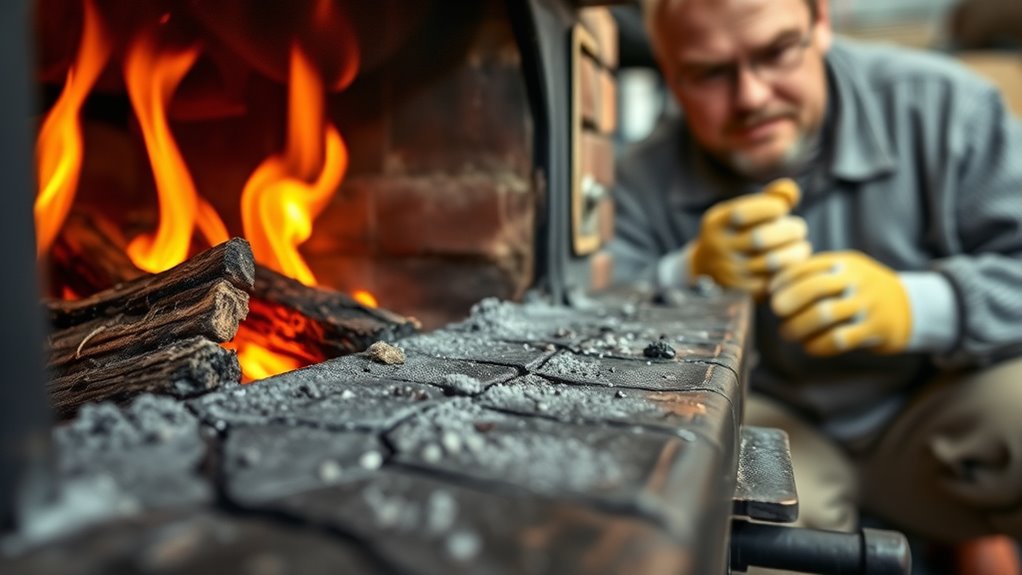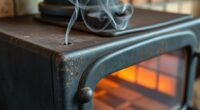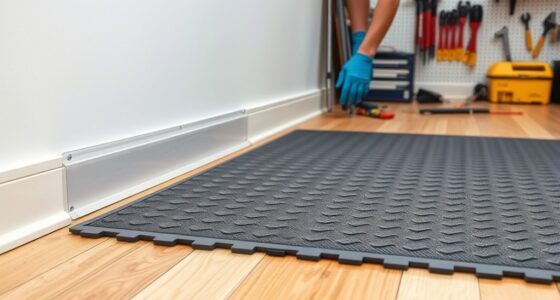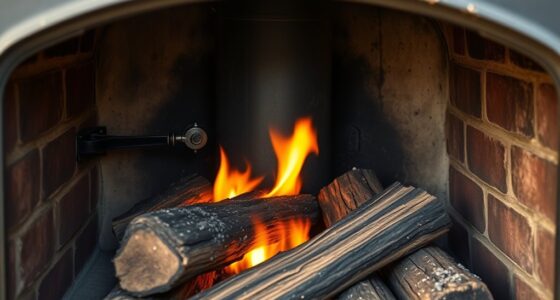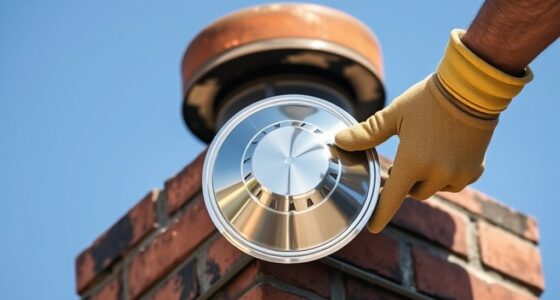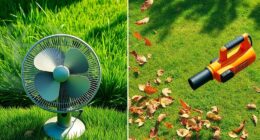You should call a professional for your wood stove whenever you notice unusual noises, persistent odors, or structural damage like cracks or warping. If you experience draft issues, difficulty maintaining a fire, or see excessive creosote buildup, it’s time to get expert help. Rust, broken seals, or signs of chimney blockages also signal the need for professional inspection. Keep watching for more tips to keep your stove safe and efficient.
Key Takeaways
- If you notice unusual noises, vibrations, or visible cracks in your stove or chimney structure.
- When smoke, odors, or draft issues persist despite cleaning and maintenance.
- If creosote buildup exceeds safe levels or you detect chimney obstructions.
- During operational difficulties like poor airflow, inconsistent heat, or strange smells.
- When alarms go off or you observe significant rust, corrosion, or structural damage.
Unusual Noises or Vibrations
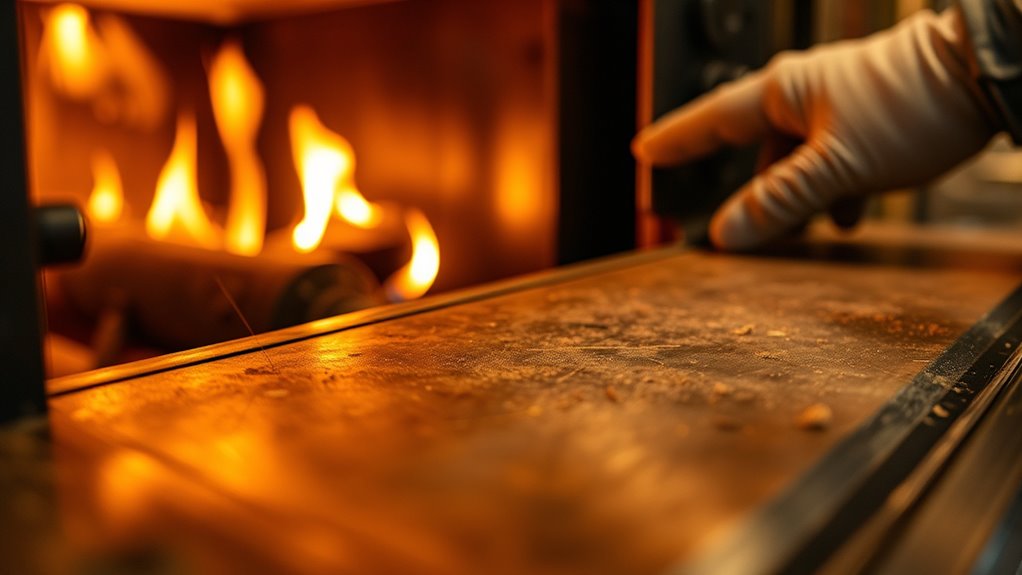
Unusual noises or vibrations from your wood stove should never be ignored, as they often signal underlying problems. If you hear banging, cracking, or popping sounds, it could be creosote buildup, loose components, or damage within the chimney or stove. These issues can lead to further damage if left unchecked. Persistent or loud noises are warning signs that you need to act quickly. Ignoring these sounds can increase the risk of damage or fire. Always consider consulting a certified technician when unusual noises occur, so they can accurately diagnose the cause and prevent potentially dangerous consequences. Additionally, proper maintenance of your wood stove can help prevent many of these issues from developing in the first place. Regular inspections and cleaning procedures are essential components of maintaining a safe and efficient stove operation. Being aware of fire safety protocols can further safeguard your home from potential hazards related to stove malfunctions. If vibrations are felt during operation, it might also indicate loose components or warped parts, which require professional attention to ensure safety. Regularly checking your stove’s installation and setup can also help identify issues early before they escalate.
Persistent Smoke or Odor Issues
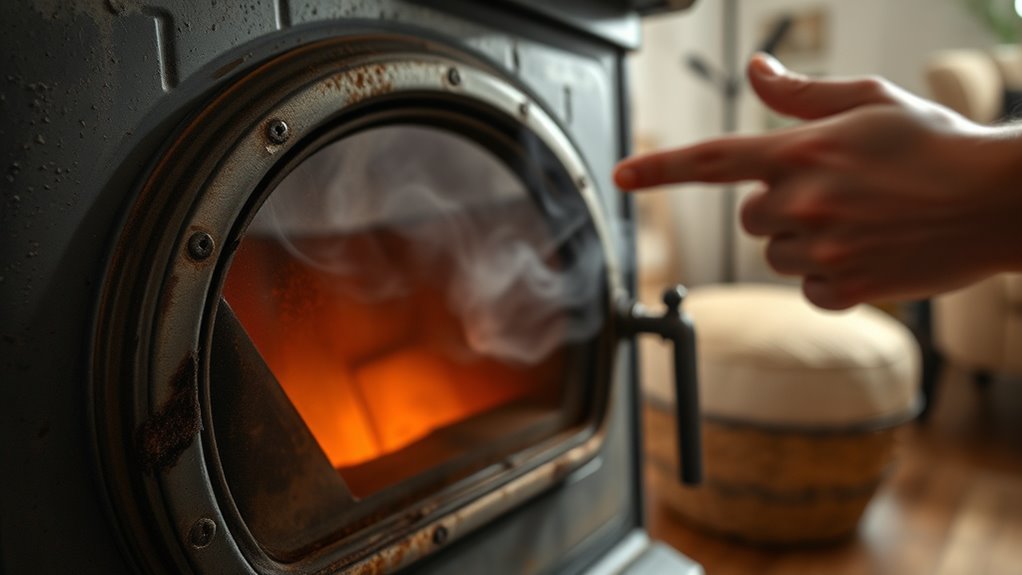
If you notice unusual smoke patterns or persistent odors, it’s a sign something’s off with your stove’s ventilation. Even if you follow proper operation, lingering smells or smoke escaping into the room mean you should get a professional to check your chimney and draft. Addressing these issues promptly helps prevent fire hazards and guarantees your stove operates safely. Additionally, regular maintenance and inspections can help prevent regulatory issues related to safety and compliance. Recognizing the importance of proper ventilation can ensure your wood stove functions efficiently and safely. A thorough assessment of airflow can often identify underlying problems that may not be immediately visible.
Unusual Smoke Patterns
Persistent smoke or strong odors coming from your wood stove often signal underlying issues like chimney blockages, creosote buildup, or venting problems. If you notice unusual smoke escaping during operation or persistent odors after cleaning, it’s a sign something isn’t right. Unusual smoke can indicate draft issues or damaged seals, which a professional technician needs to diagnose. Creosote buildup restricts airflow and causes incomplete combustion, leading to excessive or abnormal smoke patterns. These signs suggest your stove isn’t venting properly, risking fire hazards and inefficient operation. If you experience persistent or unusual smoke patterns, it’s time to call a professional. They can inspect your chimney, clear creosote, and fix venting issues, ensuring safe and ideal stove performance. Proper maintenance practices can help prevent some of these issues and keep your stove functioning safely. Regular inspections to check for venting obstructions are essential for optimal operation and safety, especially since chimney blockages can be difficult to detect without professional tools.
Persistent Odor Detection
Lingering odors or smoke after operating your wood stove can signal more than just an inconvenience; they often point to underlying safety and efficiency issues. A persistent odor may indicate creosote buildup or venting blockages that need immediate attention. Continuous smells of fuel or gasoline fumes could mean leaks or improper venting, posing serious safety hazards. Unusual odors after cleaning often reveal hidden creosote deposits or damaged seals, which require expert removal. If these odors persist despite proper operation, it’s time to seek a professional inspection. A licensed technician can evaluate airflow, chimney integrity, and combustion efficiency to identify and resolve the root problems. Regular stove maintenance and chimney inspections are essential to prevent these issues from recurring. Ensuring proper venting systems are in place can improve safety and reduce odor problems. Proper maintenance of your stove and chimney not only ensures safety but also enhances overall efficiency and reduces the risk of odors. Addressing persistent odors early helps prevent health risks and potential fire hazards, especially if venting blockages are involved. Additionally, understanding creosote buildup and its effects can help in early detection and prevention of more serious issues.
Draft and Ventilation Checks
When smoke or strong odors continue despite proper operation, it often points to a ventilation issue, such as a blocked chimney or faulty damper. Inadequate draft caused by creosote buildup or obstructions can prevent smoke from exiting, leading to indoor air quality problems. Regularly inspecting and cleaning your chimney and flues helps keep airflow unobstructed and maintains ideal draft performance. If you notice persistent issues, it’s wise to have a professional perform smoke tests or use specialized tools to diagnose ventilation blockages. Addressing draft problems early can prevent dangerous buildup and ensure your stove operates safely. Proper fuel injection cleaning can also improve your stove’s performance and reduce smoke issues. Additionally, understanding how draft and ventilation impact stove operation is essential for maintaining safe and efficient performance. Consulting with a professional chimney inspector can help identify hidden issues that might be contributing to poor draft and ensure your wood stove functions optimally. Regular maintenance and ventilation assessment are crucial for preventing recurring problems and ensuring optimal stove operation. Ensuring proper airflow management is essential for efficient and safe wood stove use.
Frequent or Excessive Creosote Buildup
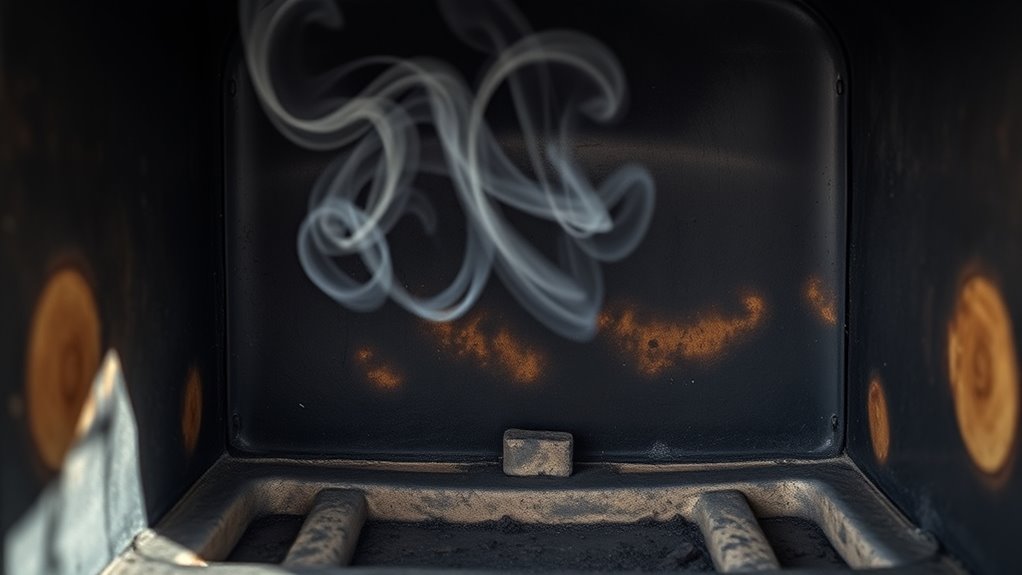
Frequent or excessive creosote buildup in your chimney is a clear sign that something isn’t working properly with your wood stove. When creosote deposits exceed 1/8 inch or become sticky and tar-like, it indicates poor combustion and inefficient maintenance. This buildup profoundly increases the risk of chimney fires, which can be devastating. If you notice persistent smoke, odors, or difficulty maintaining a fire, it’s a sign that creosote is accumulating faster than it should. Proper airflow and regular cleaning are vital, but if these issues persist, professional inspection and cleaning are essential. Addressing creosote buildup promptly helps prevent dangerous chimney fires and guarantees your stove operates safely and efficiently. Using appropriate burning techniques can also significantly reduce creosote formation. Additionally, understanding AI safety measures can help develop better safety protocols for home appliances, including wood stoves. Regularly monitoring chimney conditions can further identify early signs of hazards before they escalate. Ensuring proper chimney ventilation is crucial for maintaining efficient combustion and minimizing creosote buildup. Being aware of chimney cleaning schedules can help you stay ahead of potential issues and maintain safety. Don’t ignore these signs—call a professional before problems escalate.
Difficulty Igniting or Maintaining a Fire
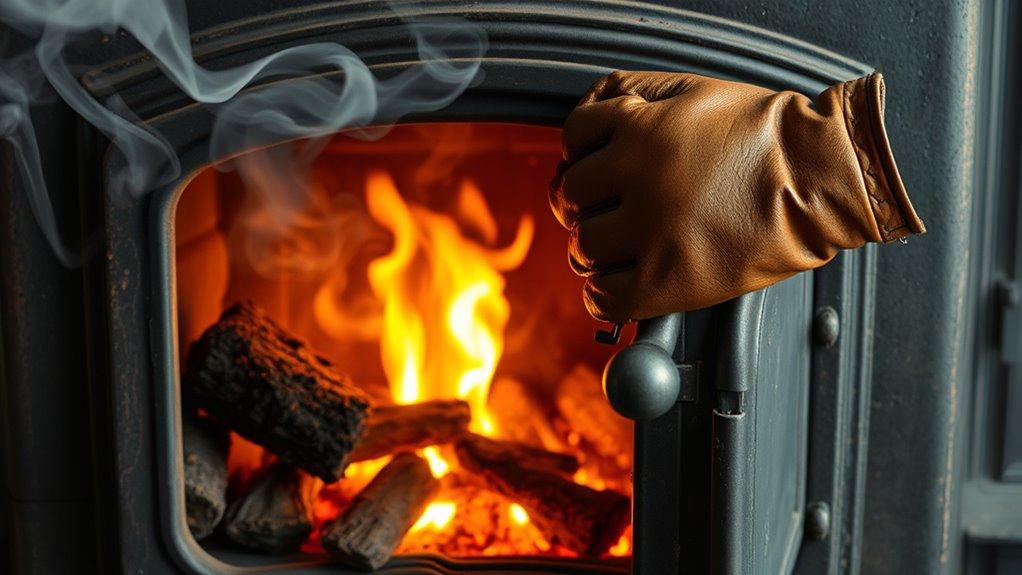
If you find it difficult to light your fire or keep it burning steadily, it could be a sign that your wood stove needs professional attention. Poor airflow or draft issues may be causing weak flames or persistent smoke, even with good fuel. A faulty damper or chimney blockage can hinder proper draft, making it hard to maintain a fire. Struggling to get consistent heat or noticing strange odors are also warning signs. Addressing these problems often requires a professional chimney sweep or technician to diagnose and repair airflow issues. Regular inspections can prevent dangerous buildup, improve efficiency, and ensure your stove operates safely. Don’t ignore ongoing trouble—professional help can restore proper draft and keep your stove functioning effectively.
- Difficulty establishing or maintaining a steady fire
- Persistent smoke or weak flames despite good wood
- Unusual odors or uneven heat output
- Draft issues that won’t resolve on their own
Cracks, Warping, or Structural Damage
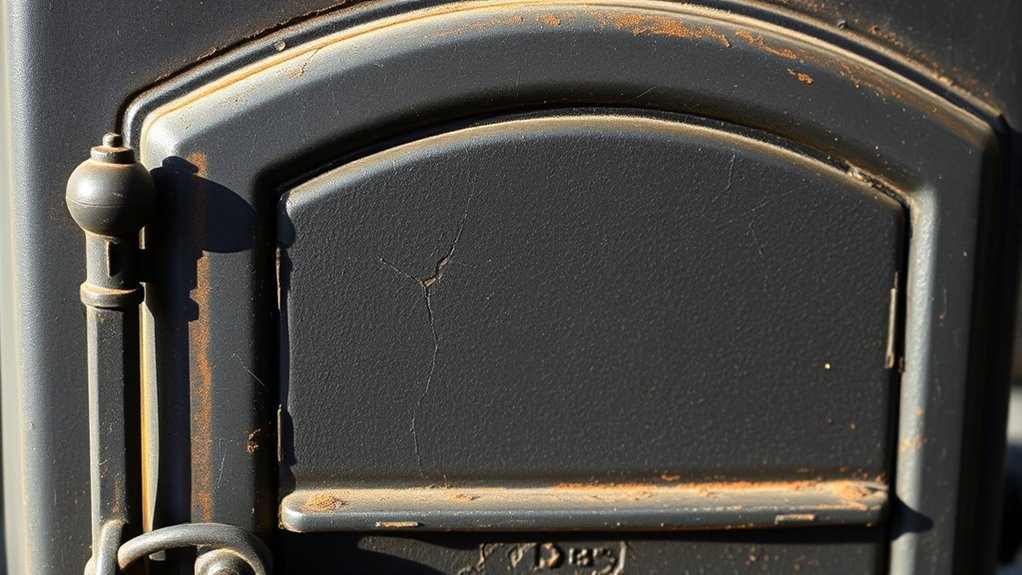
Noticing cracks, warping, or other signs of structural damage in your wood stove is a clear indication that professional help is needed. Cracks in the masonry or metal components can weaken the stove’s integrity and compromise safety. Warping of internal surfaces or panels suggests excessive heat exposure or damage that requires expert evaluation. Visible structural damage, like crumbling firebricks or broken parts, can lead to inefficient burning and safety hazards. Major cracks or warping affecting the door seal or airflow pathways can cause smoke leaks, which must be addressed promptly. If you notice any of these issues, consult a professional to assess whether repairs or replacement are necessary. Ignoring structural damage can void your warranty and jeopardize your safety.
Carbon Monoxide Alarms Going Off
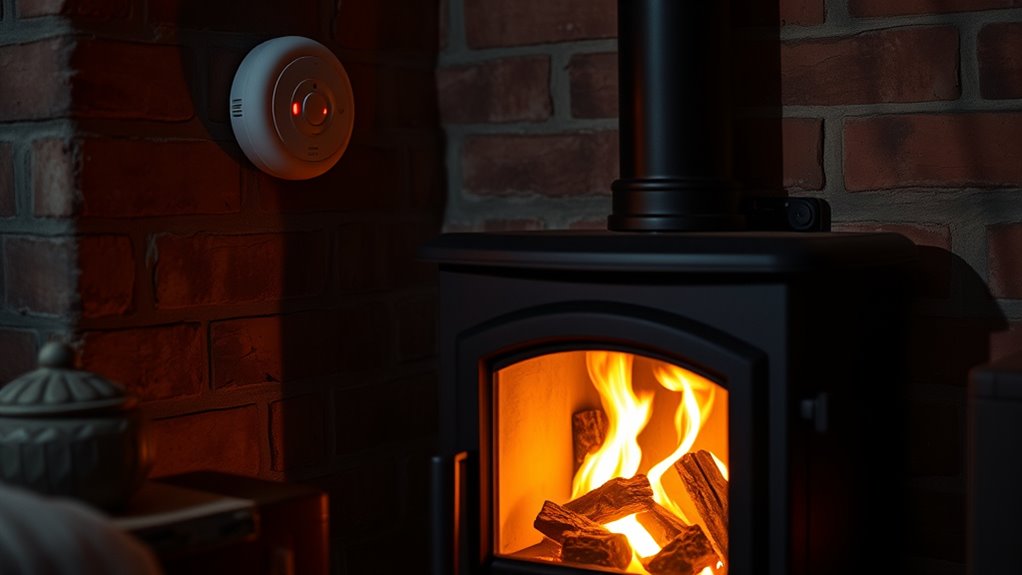
When your carbon monoxide alarm starts going off near your wood stove, it’s a clear warning of potential danger. You need to take immediate action to protect yourself and your family. Persistent CO alarms may signal incomplete combustion, venting issues, or blockages, such as creosote buildup or a cracked chimney liner. These problems can cause dangerous CO buildup inside your home.
A CO alarm near your wood stove signals danger—evacuate immediately and call a professional.
- Evacuate the area immediately and call a professional.
- Do not ignore the alarm or attempt to fix the issue yourself.
- Ensure your CO alarms are tested regularly and replaced as recommended.
- Have a professional inspect your venting system, chimney, and stove for leaks or blockages.
Never delay professional help when CO alarms go off—it’s a critical safety concern.
Reduced Heating Efficiency
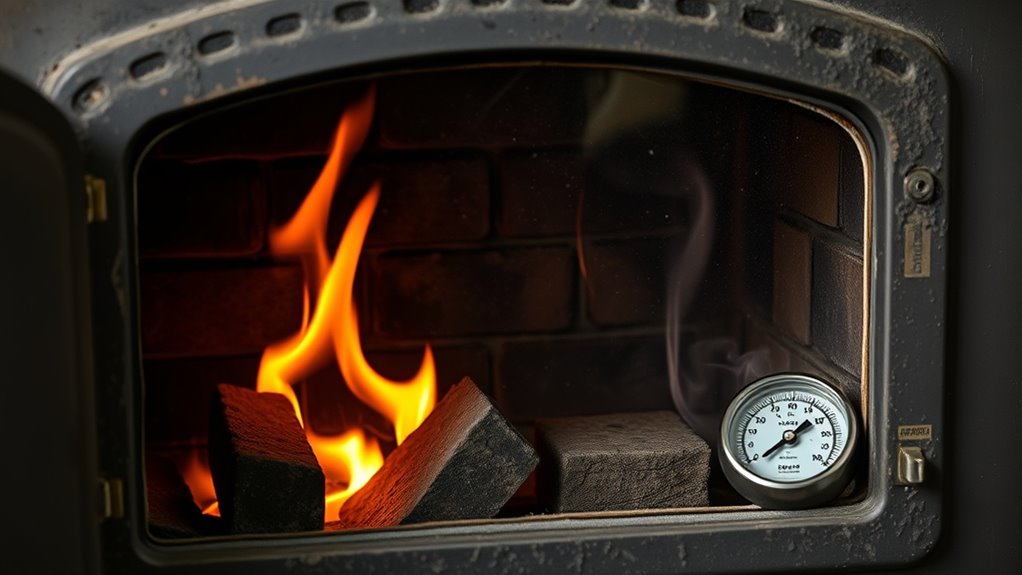
Reduced heating efficiency from your wood stove often signals that something is blocking proper airflow or that its components need professional attention. If your stove produces less heat despite using the right fuel, it could be caused by creosote buildup or a dirty chimney. Creosote can clog the chimney, restricting airflow and causing longer burn times with less warmth. Regular chimney cleaning by a certified technician helps prevent these issues and restores efficiency. Additionally, uneven heat distribution or difficulty maintaining a consistent fire may point to ventilation problems or internal damage. When you notice a sharp decline in heat output combined with increased fuel use, it’s a clear sign that professional inspection and servicing are needed to ensure safe and efficient operation.
Visible Rust, Corrosion, or Wear
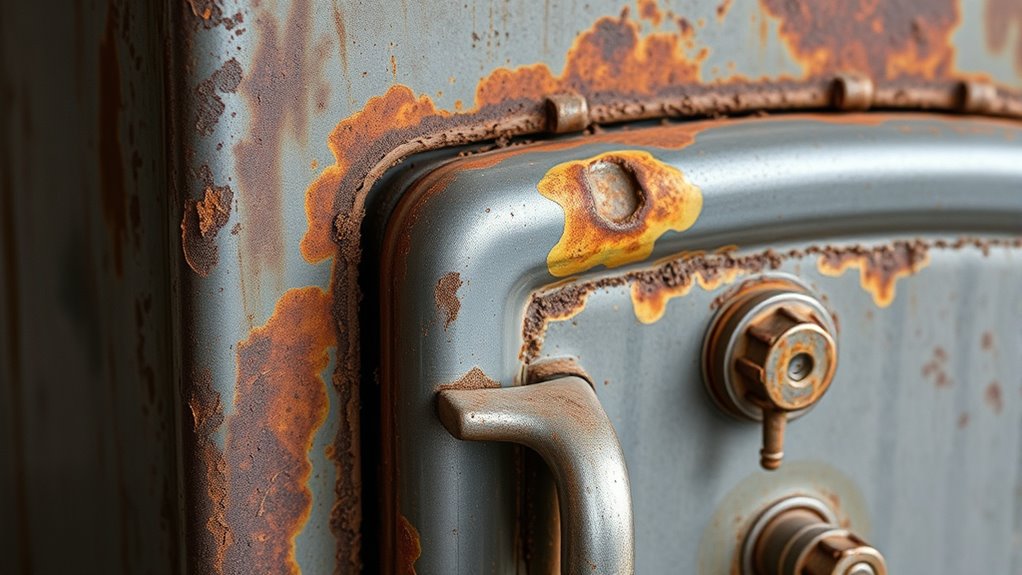
Visible rust, corrosion, or wear on your wood stove are clear signs that it may need professional attention. Rust indicates prolonged moisture exposure that weakens the metal, risking safety. Corrosion often shows as pitting or flaky patches, signaling advanced deterioration requiring expert evaluation. Wear, such as warped panels or cracked surfaces, suggests structural compromise and the need for inspection. Internal rust or corrosion on components like firebricks or gaskets can cause leaks or unsafe operation, demanding professional repair or replacement.
You should call a professional if you notice:
- Extensive rust on external or internal surfaces
- Corrosion with pitting or flaky patches
- Warped or cracked panels indicating wear
- Rust or corrosion around gaskets or firebricks
Damaged or Broken Door or Seals
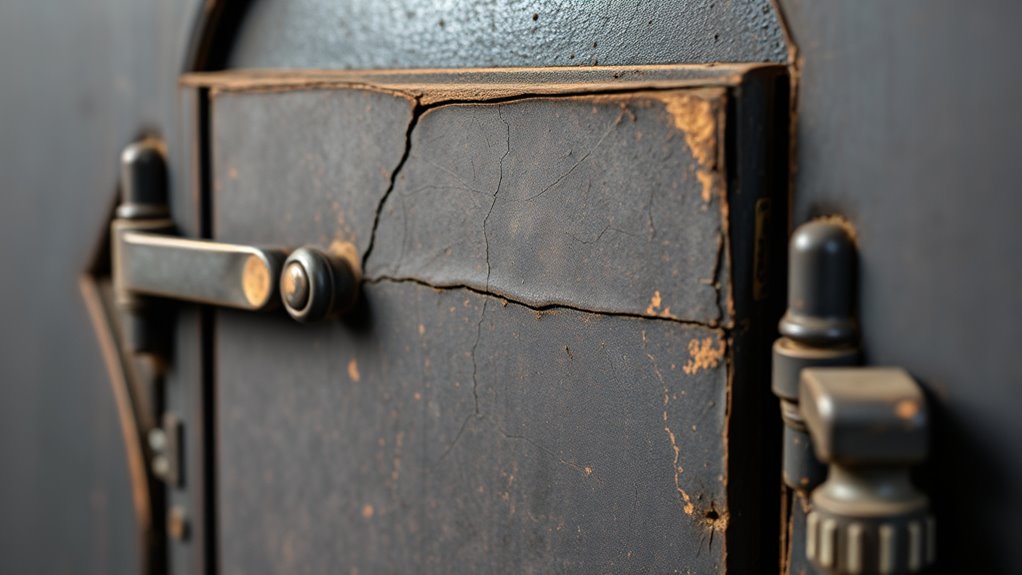
If your stove door doesn’t seal properly or shows signs of wear like tears or gaps, it’s time to get professional help. A damaged gasket or latch can cause smoke leaks and reduce efficiency, posing safety risks. Don’t overlook these issues—consult an expert to ensure safe and effective operation.
Signs of Seal Wear
Damaged or broken door seals can substantially impact your wood stove’s performance and safety. Signs of seal wear include visible damage like cracks, tears, or fraying around the door seals. Gasket wear reduces the airtight seal, causing air leaks that impair combustion and fuel efficiency. If you notice the door doesn’t close tightly or there’s an excessive draft, it’s a clear sign the seals are compromised. Increased smoke, persistent odors, or difficulty igniting the fire also point to seal issues. Regularly inspecting your stove’s door seals can help catch problems early before they worsen.
- Cracks or tears in the gasket
- Fraying or deterioration around door seals
- Difficulty closing the door tightly
- Excessive draft airflow or smoke escaping
Repair or Replace Door
When your wood stove door or seals are compromised, it can seriously affect safety and efficiency. Damaged gaskets or a warped door allow drafts, reduce heat output, and increase creosote buildup, which raises the risk of chimney fires. Cracks or warping that prevent the door from sealing properly lead to smoke leakage and unsafe conditions. If you notice persistent difficulty in closing or latching the door, or if creosote buildup is excessive, it’s time to call a professional. A qualified technician can assess whether the door can be repaired or if replacing the gasket or the entire door is necessary. Never ignore these signs, as a faulty door not only hampers heating but also compromises your safety.
Signs of Chimney Blockages or Obstructions
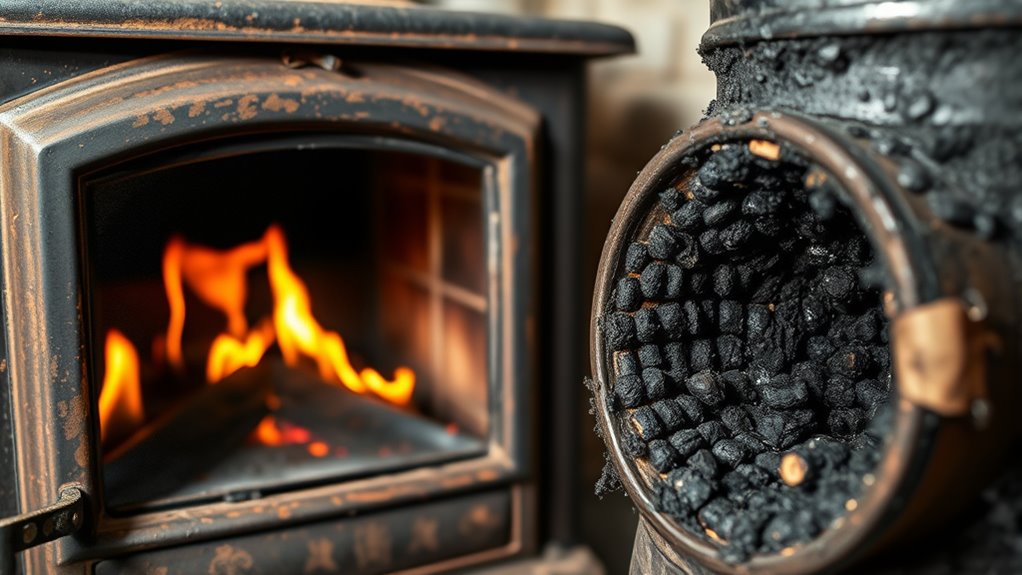
You can often spot chimney blockages by looking for visible signs like creosote buildup or black soot lining the chimney walls, which indicate potential obstructions. These issues can hinder proper venting and increase the risk of smoke or dangerous gases entering your home. Be alert to persistent downdrafts or smoke backflow, as they often point to obstructions in the chimney or flue. Unusual odors, like strong smoky or stale smells, can also signal blocked vents trapping combustion gases. Difficulties in establishing a proper draft or weak airflow during a fire are additional warning signs, possibly caused by bird nests or debris inside the chimney. Regular inspections by certified professionals are vital, especially if you notice signs like creosote buildup or animal nests that could compromise your stove’s safety and efficiency.
- Visible creosote buildup or soot on chimney walls
- Persistent downdrafts or smoke backflow
- Strong smoky or stale odors
- Difficulties in establishing proper draft
Frequently Asked Questions
What Is the 3:2-10 Rule for Wood Stoves?
The 3:2-10 rule helps you keep your wood stove safe. It means you should leave a 3-inch space from combustible materials, 2 feet from windows or vents, and 10 feet from neighboring structures. Following this rule minimizes fire risks and ensures proper ventilation and heat dissipation. Always check your stove’s instructions and local codes to confirm the specific clearances needed for your setup.
Does a Wood-Burning Stove Need to Be Serviced?
Your wood stove is your home’s heart, pumping warmth like a blazing sun. It needs regular servicing to keep that fiery core safe and efficient. If you notice persistent smoke, difficulty lighting, or strange odors, it’s time to call in a pro. Cracks, corrosion, or damaged gaskets also signal urgent attention. Regular check-ups prevent dangerous creosote buildup, extend your stove’s life, and guarantee it keeps your home cozy and safe all winter long.
How Does the 26% Tax Credit for a Wood Stove Work?
The 26% tax credit helps you save on a qualified wood stove by covering part of its cost, including installation, if purchased and installed between January 1, 2022, and December 31, 2023. To claim it, you file IRS Form 5695, keep receipts, and manufacturer certification. Remember, this non-refundable credit reduces your tax liability but won’t provide a refund beyond what you owe.
Does a Wood Stove Make Your Insurance Go Up?
A wood stove can raise your insurance premiums because it’s considered a fire risk. To keep coverage safe, you should have it professionally installed and regularly maintained. Failing to do so might lead to higher costs or even claim denial. Always check your policy and talk to your insurer before installing or servicing your stove, so you know what safety standards to meet and avoid surprises.
Conclusion
Ignoring these warning signs can lead to costly repairs or dangerous chimney fires. Did you know that creosote buildup alone causes over 25,000 house fires each year? If your wood stove shows any of these issues, don’t wait—call a professional. Addressing problems early keeps your home safe, warm, and cozy all season long. Stay vigilant, and enjoy peace of mind knowing your stove operates safely and efficiently.

